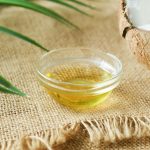To tackle grease stains on your cotton apron, act fast! Blot the stain with a paper towel to soak up excess grease, then sprinkle baking soda or cornstarch to absorb the residue. Apply dish soap or stain remover, let it sit for 5-10 minutes, and rinse with cold water. Washing in cold water, either by machine or hand, guarantees the fabric remains intact. Want to know more tips for keeping your apron spotless?
Table of Contents
Key Takeaways
- Blot the grease stain immediately to absorb excess oil without spreading it further.
- Sprinkle baking soda or cornstarch on the stain to absorb remaining grease before treating it.
- Apply dish soap or a stain remover directly to the stain and let it sit for 5-10 minutes.
- Rinse the treated area with cold water and repeat if the stain persists before washing.
- Always wash aprons in cold water and air dry to maintain fabric integrity and prevent shrinkage.
Types of Grease Stains on Cotton Aprons
Grease stains on cotton aprons can come from various sources, each requiring a different approach to tackle effectively.
Cooking oil spills are common, often splattering from frying pans or saucepans. Butter stains can also appear, especially when you’re working with pastries.
Then there are the more stubborn grease marks from food items like cheese, which can cling tightly to fabric. Additionally, automotive grease is another culprit, particularly if you’re in a workshop or garage setting.
Each type of grease stain demands your attention, as the way you treat them can make a significant difference. Identifying the source of the stain helps you choose the best method for removal, ensuring your apron stays clean and functional for your culinary adventures.
Key Materials for Grease Stain Removal
When tackling grease stains on your cotton apron, having the right materials on hand can make all the difference.
You’ll want to be prepared with a few essential items that can effectively break down and lift the grease.
Here’s a quick list of what you should gather:
- Dish Soap: The powerful degreasing properties of dish soap work wonders on grease stains.
- Baking Soda: This natural abrasive helps absorb grease and can be used as a gentle scrub.
- White Vinegar: A natural stain remover, vinegar can help cut through tough grease and eliminate odors.
Having these materials at your disposal will set you up for success in removing those pesky grease stains from your cotton apron.
Step-by-Step Removal Methods
To effectively remove grease stains from your cotton apron, follow these simple step-by-step methods.
First, gently blot the stain with a paper towel to absorb excess grease.
Next, sprinkle baking soda or cornstarch on the stain and let it sit for about 15 minutes. This helps absorb the oil.
After that, brush off the powder and apply a stain remover or liquid dish soap directly to the stain, gently rubbing it in with your fingers or a soft cloth.
Let it sit for another 5-10 minutes.
Finally, rinse the area with cold water and inspect the stain. If it’s still visible, repeat the process before washing the apron according to its care instructions.
Machine vs. Hand Washing
After treating those stubborn grease stains, you’ll need to decide how to wash your cotton apron.
Both machine and hand washing can be effective, but each method has its perks.
Both machine and hand washing offer unique benefits, so consider which method suits your needs best.
- Machine Washing: If you’re short on time, tossing your apron in the washing machine is quick and efficient. Just make sure to choose a gentle cycle and cold water to protect the fabric.
- Hand Washing: This method allows for more control over the stain removal process. You can gently scrub the stained areas, ensuring a deep clean without risking damage.
- Fabric Care: Always check the care label. Some cotton aprons may require hand washing to maintain their shape and color.
Choose the method that best fits your schedule and care needs!
Scientific Principles Behind Grease Removal
Understanding the scientific principles behind grease removal can greatly enhance your stain-fighting efforts.
Grease is a type of lipid, insoluble in water but easily broken down by solvents. When you apply a detergent, it contains surfactants that reduce surface tension, allowing water to mix with grease.
These surfactants have hydrophilic (water-attracting) and hydrophobic (water-repelling) ends, enabling them to surround grease particles and lift them away from fabric.
Heat also plays a significant role; warm water can dissolve grease more effectively, enhancing the action of your chosen cleaning agent.
Best Practices for Stain Treatment
When tackling grease stains on your cotton apron, following a few best practices can make all the difference.
Here are three key tips to guarantee effective stain treatment:
Here are three essential tips to ensure successful grease stain removal from your cotton apron.
- Act Fast: The sooner you treat the stain, the better your chances of removal. Don’t wait for it to set in.
- Blot, Don’t Rub: Use a clean cloth to blot the stain gently. Rubbing can spread the grease and damage the fabric.
- Choose the Right Detergent: Opt for a grease-fighting detergent or pre-treatment spray. Look for products specifically designed for grease removal.
Dealing With Fresh Grease Stains
When you spot a fresh grease stain on your cotton apron, quick action is essential.
The sooner you treat it, the better your chances of complete removal.
We’ll explore effective methods to tackle those stubborn stains right away.
Quick Action Required
To effectively tackle fresh grease stains on your cotton apron, it’s essential to act quickly before the stain sets. The longer you wait, the harder it becomes to remove the stain.
Here’s what to do immediately:
- Blot the Stain: Use a clean cloth or paper towel to gently blot the grease, absorbing as much as possible without rubbing.
- Sprinkle Absorbent Material: Sprinkle cornstarch or baking soda directly on the stain. These powders will help absorb the grease.
- Let it Sit: Allow the absorbent material to sit for at least 15 minutes to draw out the grease before brushing it off.
Effective Treatment Methods
While immediate action is essential, knowing the right treatment methods can make all the difference in effectively removing fresh grease stains from your cotton apron.
Start by blotting the stain gently with a paper towel to absorb excess grease. Next, sprinkle baking soda or cornstarch directly onto the stain; let it sit for about 15 minutes to absorb the remaining grease.
Afterward, gently brush off the powder and apply a few drops of dish soap to the stained area. Rub it in with your fingers or a soft brush. Rinse with cold water, then launder the apron as usual.
Always check the stain before drying; if it’s still visible, repeat the process to guarantee complete removal.
Tackling Set-in Grease Stains
Even if you’ve tried to remove that stubborn grease stain from your cotton apron multiple times, there’s still hope for a successful outcome.
Tackling set-in grease stains requires persistence and the right approach. Here are three effective steps you can take:
- Pre-treat the stain: Apply a small amount of dish soap or a stain remover directly onto the grease stain. Let it sit for at least 15 minutes.
- Scrub gently: Use a soft-bristled brush or cloth to gently work the soap into the fabric, loosening the grease.
- Wash as usual: Launder the apron in the hottest water safe for cotton. Check if the stain is gone before drying, as heat can set it permanently.
With these steps, you can reclaim your apron!
Special Considerations for Industrial Grease
When dealing with industrial grease on your cotton apron, it’s crucial to understand that this type of grease often requires specialized treatment due to its heavy-duty nature.
First, avoid using regular detergents, as they may not penetrate the thick grease effectively. Instead, look for a degreaser specifically designed for industrial use. Apply it directly to the stained area and let it sit for a few minutes to break down the grease.
Afterward, scrub gently with a soft brush, ensuring you don’t damage the fabric. Rinse thoroughly with hot water to remove any residue.
If the stain persists, don’t hesitate to repeat the process. Remember, prompt action is key to preventing the grease from setting in permanently.
Tips for Maintaining Clean Cotton Aprons
To keep your cotton aprons looking fresh, establish a regular washing schedule that fits your cooking routine.
Don’t wait to treat stains; handle them immediately for the best chance of removal.
Also, make sure you store your aprons properly to prevent any unwanted odors or damage.
Regular Washing Schedule
While maintaining a regular washing schedule might seem tedious, it’s essential for keeping your cotton apron in top condition. Consistent washing not only prevents dirt and grease build-up but also extends the life of your apron.
Here are a few tips to help you establish a routine:
- Choose a Frequency: Wash your apron after every few uses, or weekly if you cook often.
- Use Cold Water: Cold water preserves colors and fabric integrity, making it ideal for cotton.
- Air Dry: Instead of using a dryer, hang your apron to air dry. This prevents shrinking and damage.
Immediate Stain Treatment
Immediate action is key to successfully treating grease stains on your cotton apron. As soon as you notice a stain, gently blot it with a paper towel to absorb excess grease. Next, sprinkle baking soda or cornstarch on the stain to help absorb the oil. Wait about 15 minutes before brushing it off. For tougher stains, apply a small amount of dish soap mixed with warm water and gently scrub the area with a soft cloth. Rinse with cold water and wash as usual. Here’s a quick reference guide to help you:
| Step | Action | Tips |
|---|---|---|
| Blot | Use a paper towel | Don’t rub, just blot |
| Absorb | Sprinkle baking soda | Leave for 15 minutes |
| Apply | Mix dish soap with water | Use a soft cloth to scrub |
| Rinse | Use cold water | Prevents setting the stain |
| Wash | Follow regular washing | Check label for instructions |
Proper Storage Techniques
Properly storing your cotton aprons can greatly prolong their lifespan and keep them looking fresh.
By following a few simple techniques, you can guarantee your aprons remain in top condition for years to come.
- Fold Neatly: Always fold your aprons neatly to prevent creases and wrinkles.
- Use a Hanger: Hang your aprons on a sturdy hanger to avoid any fabric stretching or distortion.
- Store in a Dry Place: Keep them in a cool, dry area to prevent mildew and odors.
Frequently Asked Questions
Can I Use Bleach on Grease Stains?
When it comes to grease stains, you can’t throw caution to the wind. Bleach might not be your best bet, as it can cause discoloration. Stick to other stain removers for better results.
What Should I Avoid When Treating Grease Stains?
When treating grease stains, avoid using hot water, as it can set the stain. Don’t apply bleach directly, since it can react poorly. Also, steer clear of rubbing too hard, which can damage the fabric.
How Can I Prevent Grease Stains on My Apron?
To prevent grease stains, you should wear an apron while cooking, keep a towel handy for quick spills, and avoid leaning over hot pans. Plus, always clean up splatters immediately to stop stains from setting.
Is It Safe to Mix Cleaning Products?
Mixing cleaning products can be playing with fire. You shouldn’t do it unless you’re sure it’s safe. Always read labels, as some combinations can create harmful fumes or reactions. Better safe than sorry, right?
How Can I Tell if a Stain Is Set-In?
You can tell if a stain’s set-in by checking its color and texture. If it feels rough or appears darker than the surrounding fabric, it’s likely set-in. Don’t forget to test different cleaning methods!
- Does Chiffon Fabric Stink - July 15, 2025
- Does Chiffon Fabric Affect the Economy - July 15, 2025
- Does Cotton Fabric Have a Nap - July 15, 2025







